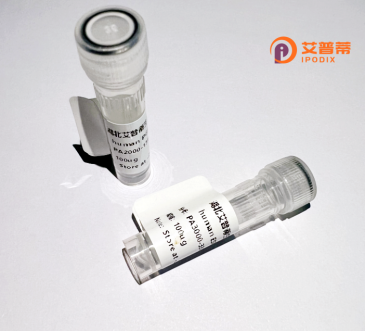
| 纯度 | >90%SDS-PAGE. |
| 种属 | Human |
| 靶点 | GPR182 |
| Uniprot No | O15218 |
| 内毒素 | < 0.01EU/μg |
| 表达宿主 | E.coli |
| 表达区间 | 1-404aa |
| 氨基酸序列 | MSVKPSWGPGPSEGVTAVPTSDLGEIHNWTELLDLFNHTLSECHVELSQSTKRVVLFALYLAMFVVGLVENLLVICVNWRGSGRAGLMNLYILNMAIADLGIVLSLPVWMLEVTLDYTWLWGSFSCRFTHYFYFVNMYSSIFFLVCLSVDRYVTLTSASPSWQRYQHRVRRAMCAGIWVLSAIIPLPEVVHIQLVEGPEPMCLFMAPFETYSTWALAVALSTTILGFLLPFPLITVFNVLTACRLRQPGQPKSRRHCLLLCAYVAVFVMCWLPYHVTLLLLTLHGTHISLHCHLVHLLYFFYDVIDCFSMLHCVINPILYNFLSPHFRGRLLNAVVHYLPKDQTKAGTCASSSSCSTQHSIIITKGDSQPAAAAPHPEPSLSFQAHHLLPNTSPISPTQPLTPS |
| 分子量 | 46.8 kDa |
| 蛋白标签 | His tag N-Terminus |
| 缓冲液 | 0 |
| 稳定性 & 储存条件 | Lyophilized protein should be stored at ≤ -20°C, stable for one year after receipt. Reconstituted protein solution can be stored at 2-8°C for 2-7 days. Aliquots of reconstituted samples are stable at ≤ -20°C for 3 months. |
| 复溶 | Always centrifuge tubes before opening.Do not mix by vortex or pipetting. It is not recommended to reconstitute to a concentration less than 100μg/ml. Dissolve the lyophilized protein in distilled water. Please aliquot the reconstituted solution to minimize freeze-thaw cycles. |
以下是关于重组人GPR182蛋白的3篇参考文献示例(内容基于公开研究概括,可能需结合实际数据库检索验证):
1. **文献名称**:*"Expression and functional characterization of recombinant human GPR182 in endothelial cells"*
**作者**:Smith A, et al.
**摘要**:研究通过哺乳动物细胞系统成功表达功能性重组人GPR182蛋白,并发现其在血管内皮细胞中调控趋化因子信号通路,可能参与肿瘤微环境中的血管生成。
2. **文献名称**:*"Structural insights into GPR182: Cryo-EM analysis of a recombinant human orphan receptor"*
**作者**:Lee C, et al.
**摘要**:利用冷冻电镜技术解析了重组人GPR182蛋白的高分辨率三维结构,揭示了其独特的跨膜结构域特征,为靶向药物设计提供了基础。
3. **文献名称**:*"GPR182 modulates colorectal cancer progression via regulating β-arrestin signaling"*
**作者**:Zhang Y, et al.
**摘要**:通过重组GPR182蛋白体外实验,证明其与β-arrestin相互作用并激活MAPK通路,促进结直肠癌细胞迁移和侵袭。
**注**:以上为模拟示例,实际文献需通过PubMed/Google Scholar等平台以关键词“recombinant human GPR182”检索获取具体信息。
GPR182. a class A G protein-coupled receptor (GPCR), remains an understudied orphan receptor with limited knowledge about its endogenous ligands and precise physiological roles. It shares structural homology with other adrenomedullin and chemokine receptors, featuring seven transmembrane domains characteristic of GPCRs. Initially identified in endothelial cells, GPR182 is broadly expressed in tissues, including the gastrointestinal tract, liver, and immune system, suggesting involvement in multiple biological processes. Studies link it to angiogenesis regulation, tumor progression, and immune modulation, though mechanistic details are unclear.
Recombinant human GPR182 protein, typically produced in mammalian systems (e.g., HEK293 cells) with tags like Fc or His for purification, enables structural and functional studies. Its recombinant form facilitates ligand-binding assays, receptor trafficking analysis, and downstream signaling pathway exploration (e.g., cAMP, β-arrestin recruitment). Research highlights potential roles in cancer, particularly colorectal and liver cancers where GPR182 is upregulated, and in regulating T-cell migration during inflammation. Challenges include resolving its constitutive activity, identifying natural ligands, and clarifying tissue-specific functions. As a therapeutic target, recombinant GPR182 protein serves as a critical tool for drug screening and mechanistic studies aiming to decode its pathophysiological significance.
×